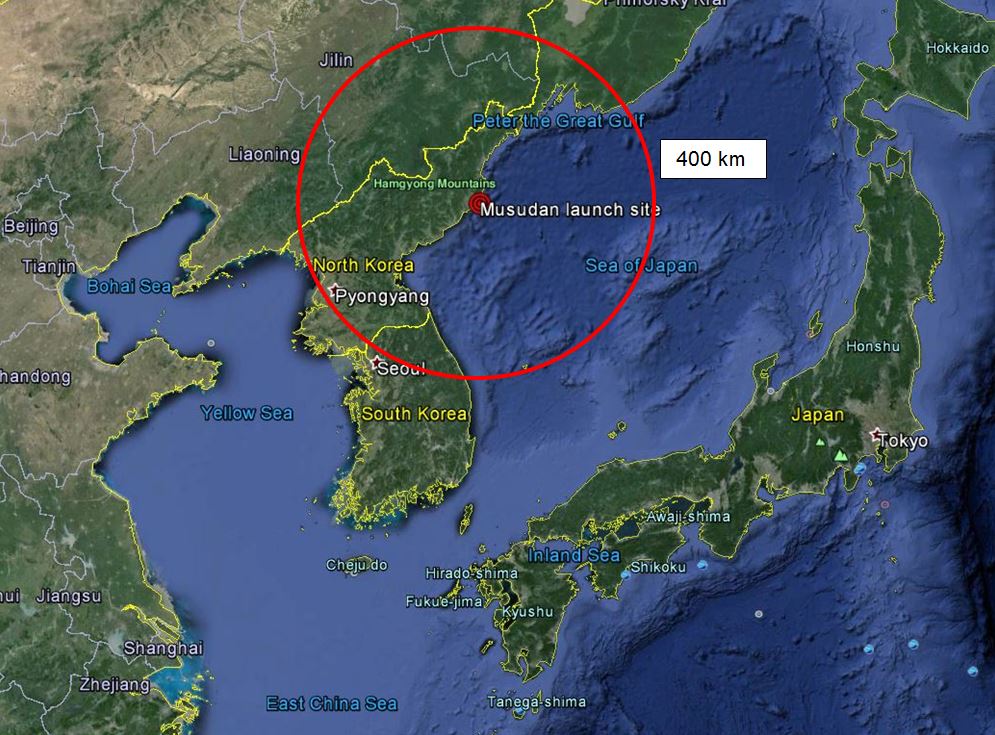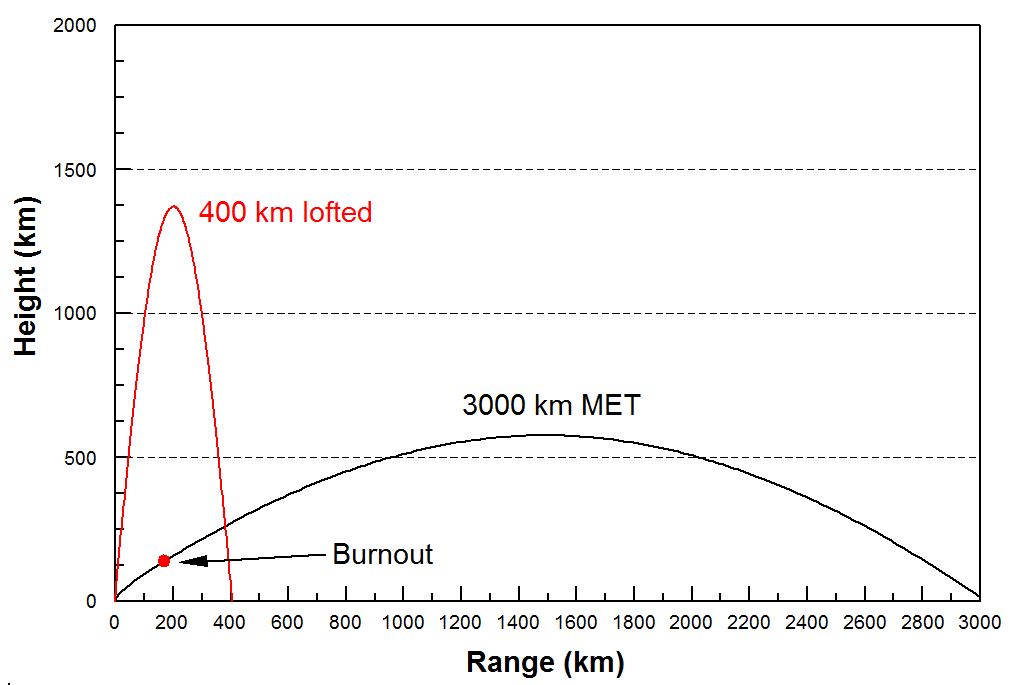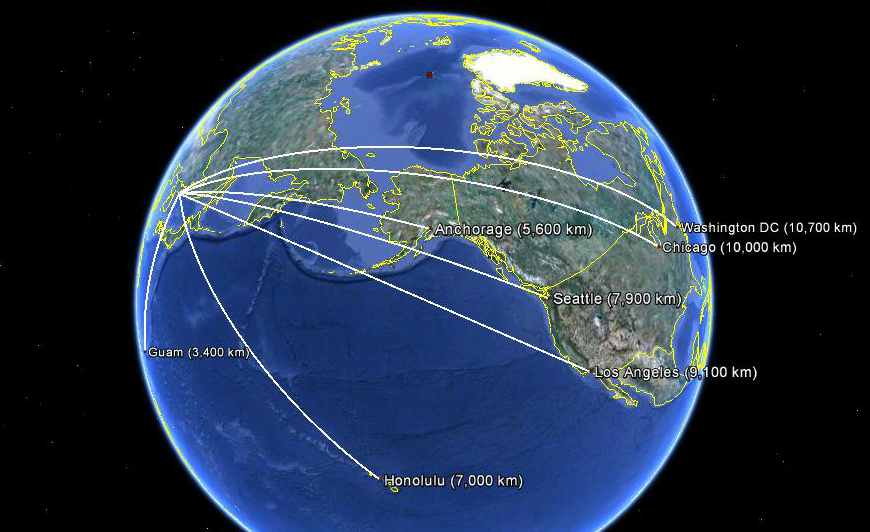After four failed attempts to launch its so-called Musudan missile (called Hwasong-10 in North Korea), it appears to have had at least one success in a new sets of flight tests on June 21. That test tells us something interesting about the range of the missile.
The second of the two launches on June 21 apparently flew successfully, but followed an unusual trajectory. It splashed down into the Sea of Japan at a range of only 400 km from the launch site, but was highly lofted so that it reached an altitude of 1,400 km.
Using this trajectory allowed North Korea to test the missile from its military launch site on the country’s east coast without flying over Japan, since the Musudan’s range on a standard trajectory is about twice as great as the distance from North Korea to Japan (Fig. 1). A past overflight of Japan caused serious international tensions and it seems likely this launch was intended to test the missile while avoiding that.

Fig. 1 The red circle shows a range of 400 km from the launch site. (Source: Google Earth, with additions)
Range of the Musudan missile
Knowing the range and maximum altitude of the test flight allows us to estimate the range of the Musudan if it were launched on a standard trajectory.
I put together a computer model of the missile based on estimates of parameters like thrust, engine burntime, payload, etc. I then adjusted those parameters to give a range of 400 km with an apogee of 1,400 km. Using those same parameters, I then calculated what the maximum range of that missile would be if flown on a non-lofted trajectory. The result of that calculation is shown in Fig. 2.
That calculation shows that the Musudan’s range would be about 3,000 km on a standard “minimum-energy” (MET) trajectory, assuming the same payload as the lofted test.

Fig. 2 The red curve shows the lofted trajectory that was reportedly used in the second test on June 21. The black curve shows the trajectory of the same missile flown on a standard “minimum-energy” trajectory (MET).
This is an interesting result because it is significantly shorter than many estimates of the Musudan range. For example, this WikiLeaks document gives an official US range estimate of 4,000 km with a 500 kg payload.
I have long been skeptical of those range claims. The Musudan is believed to be based on a Soviet submarine-launched missile, the SSN-6, which the Koreans have lengthened to carry more fuel and increase its range. My analysis based on the performance of the SSN-6 suggests instead a Musudan range of about 3,500 km with a 500 kg payload, and about 3,000 km with a 750 kg payload.
We don’t, of course, know what payload was used on the test. Maybe the missile carried a much heavier payload than 500 kg. But it would make sense for North Korea to conduct the test with the payload it would expect the missile to carry if it was actually used. For example, the reentry heating on a 4,000 km range missile would be nearly 40% higher than on a 3,000 km range missile, given the higher reentry speed. So the North would want to test on the equivalent of a 4,000 km range trajectory if it expected to fly the missile to that distance.
The 3,000 km range is also interesting since it is shorter than the distance to Guam, which is about 3,400 km (Fig. 3). Being able to reach Guam is seen as a key motivation for the Musudan since Guam has a US military base and is the next logical target for North Korea after its development of the Nodong missile to reach Japan.
If this test reflects the state of the art of North Korea’s missile and warhead technology it could mean that North Korea’s nuclear warhead is currently too heavy for the Musudan to carry it to Guam.

Fig. 3 (Source: Google maps, with additions)
The “failure” of the first launch on June 21
Reports state that the first missile launched on June 21 broke up at a range of about 150 km and fell into the sea. That may have resulted from a simple mechanical failure, although it is not clear what would have caused it at that point in the flight.
There may be another possibility. It is unclear from press reports whether or not this missile was also flown on a lofted trajectory. If it was instead flown on a standard trajectory, it is interesting that 150 km range corresponds roughly to burnout of the Musudan engines (see red dot in Fig. 2).
Is it possible that Pyongyang launched the first missile on a standard trajectory to test the guidance and control system, and then intentionally terminated the flight following burnout to keep it from overflying Japan? That would allow them to test on a standard trajectory the guidance and control systems that operate in the early part of flight. The second test on the lofted trajectory would allow them to test the operation of the reentry heat shield in the later part of the flight. We discuss that more in Part 2 of this post.
So it would be very useful to know what trajectory the first missile followed.
